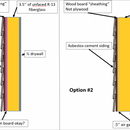Inuslating 1885 House in Ohio
Hello all,
Long time lurker and finally have my first question as we do a renovation on the house we just bought. 1.5 stories and I believe to be balloon framed, built in 1885. We are in climate zone 5A – NW Ohio. For previous forums I understand the importance of fire blocking and sealing up this old house from water intrusion as they weren’t designed for insualtion.
It didn’t have any insulation behind the plaster and lathe. We currently have it down to the studs and want to insulate the whole house before drywall. For the first floor insulation I am thinking either option 1 or 2 but want to get some opinions.
I wasn’t planning to use a vapor barrier but I am seeing some conflicting information online in regards to the kraft paper as a barrier. What would be best in my situation? Maybe I use unfaced batts and 6 mil plastic?
Option #1 comments: Since the studs are a true 4″ I thought I could add the foam board as additional insulation/wind block. The house is in the middle of a field so it gets pretty consistent winds. I am planning to caulk and foam any drafts I find but thought this would just be added protection. I saw conflicting opinions on this. What I got is rigid foam acts as a vapor retarder and adding a second barrier would just cause issues. If I am able to go this route I wouldn’t use plastic and use unfaced batts.
Option #2 comments: Since the studs are a true 4” would I put the .5” air gap between the insulation and drywall, or between the outside and insulation? The insulation might just fluff up enough to where this isn’t an issue?
I am planning to use mineral wool around all the windows and doors due to its water resistant properties. I just can’t get enough of it in time to do the whole house.
Maybe both of my proposals are wrong so let me know what you guys think or if you need any more information.
GBA Detail Library
A collection of one thousand construction details organized by climate and house part










Replies
There are many details to pay attention to in an old-house retrofit. First, you absolutely must make sure that bulk water is properly addressed at the exterior walls. Many houses this age do not have very good water management. Most don't even have building paper or even reasonably continuous sheathing behind the siding. If this is the case, you should follow the directions in this article:
https://www.greenbuildingadvisor.com/article/managing-water-and-insulating-walls-without-sheathing
1/2" XPS works well as the cut&cobble insulation behind the siding and seal it well inside the stud perimeter. At 1/2", it is a Type II Vapor Retarder, which is semi-permeable. If you do an excellent job sealing this in place, you can probably get away with latex paint as your interior VR, though Kraft paper would be better and one of the smart membranes would still be a better choice.